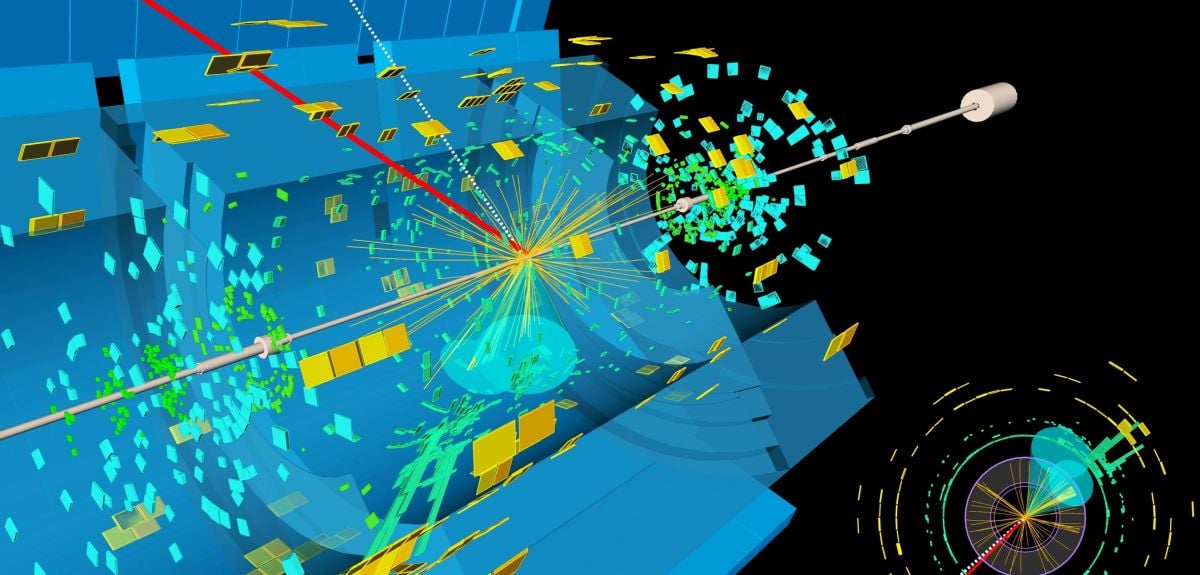
Image credit: CERN
Hunting the elusive Higgs boson
Professor Daniela Bortoletto of Oxford University’s Department of Physics explains how a new result from the Large Hadron Collider sheds vital light on the elusive Higgs boson.
Particle physicists have – at long last – observed the Higgs boson decaying into a pair of bottom (b) quarks at the Large Hadron Collider (LHC). This elusive interaction is predicted to make up almost 60% of the Higgs boson decays. Yet it took over seven years to accomplish this observation. This discovery was announced at CERN on August 28 both by ATLAS and CMS.
ATLAS is one of the four major experiments at the Large Hadron Collider (LHC) at CERN. It is a general-purpose particle physics experiment run by an international collaboration and, together with another experiment, CMS, is designed to exploit the full discovery potential and the huge range of physics opportunities that the LHC provides.
The result is a confirmation of the Standard Model. During the early preparations of the LHC, there were doubts on whether this observation could be achieved. Our success is thanks to the excellent performance of the LHC and the ATLAS detector, and the application of highly sophisticated analysis techniques to our large dataset.
UK groups including the Universities of Birmingham, Glasgow, Liverpool, Queen Mary, Oxford and UCL have made important contributions to this historic achievement.
Finding Higgs boson decaying into a pair of b quarks at the LHC is challenging. Since the LHC collisions produce b-quark pairs in great abundance it is essential to select events where the Higgs boson appears alongside a W or Z particle, which makes the events easier to tag. Our team in Oxford analysed elusive W and Z bosons decays where the decay products of these particles are not directly identified in the detector but are inferred from a large transverse energy imbalance in the event.
Our postdoc researcher, Elisabeth Schopf and my students, Cecilia Tosciri and Luca Ambroz, made significant contributions to the result. Elisabeth played a leading role in optimizing the sophisticated machine learning algorithms that allowed ATLAS to increase the sensitivity to these events. Luca established a new technique that used Monte Carlo events in a clever way and lead to a higher expected significance for the analysis. Cecilia upgraded a method to improve the resolution achieved in the measurements of the decay of the Higgs boson into b-quarks.
This is a very special moment for me personally, and the culmination of an even longer wait. I started looking for the decays of the Higgs boson to b-quarks at the US proton-proton TEVATRON collider with the CDF detector in 2005. Four of my former students completed their theses on searches for the Higgs in events with large transverse missing energy and b-quarks between 2007 and 2012.
The results of this work were used in the final TEVATRON combination which reached about three standard deviations in 2012 - not enough for a discovery. I am delighted that the LHC finally unveiled this important decay mode of the Higgs boson. I did not have any doubt that at the end of this tour de force we will pass the significance of five standard deviations which is necessary to claim a discovery. The LHC is a more powerful accelerator than the TEVATRON and ATLAS is a superb detector.
I believe that this measurement will improve our understanding of the mechanism of mass generation and its possible connections with cosmology and astrophysics.
This is also a new confirmation of the so-called “Yukawa couplings”. Similar to the Higgs mechanism, these couplings to the Higgs field provide mass to charged fermions (quarks and leptons), which are the building blocks of matter. Combined analyses of the Run-1 and Run-2 datasets have resulted in the first measurements of these couplings, as seen in the recent ATLAS observation of Higgs boson production in association with a top-quark pair and the observation of the Higgs boson decaying into pairs of tau leptons.
This result also establishes, for the first time, the production of a Higgs boson in association with a vector boson above five standard deviations. ATLAS has now observed all four main production modes of the Higgs boson. These observations mark a new milestone in the study of the Higgs boson, as ATLAS transitions from observations to precise measurements of its properties.
We now have the opportunity to study the Higgs boson in unprecedented detail and will be able to further challenge the Standard Model.